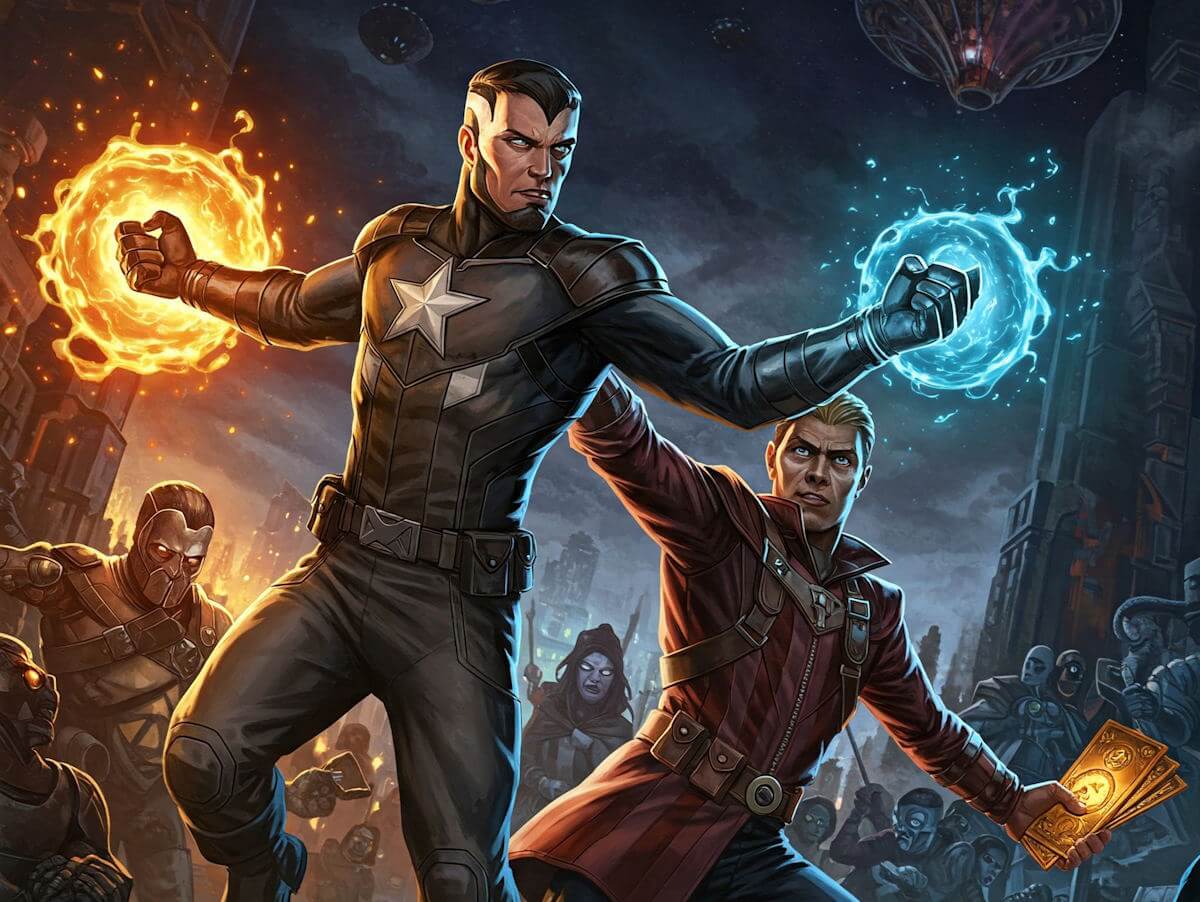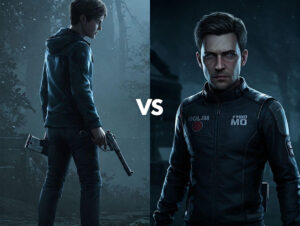Marvel’s Midnight Suns represents a significant evolution in the realm of superhero-themed video games, blending traditional role-playing game (RPG) elements with innovative tactical gameplay mechanisms. Developed by Firaxis Games, known for their success in strategy gaming, this title unveils a captivating story set in the darker corners of the Marvel Universe. The game draws its narrative inspiration from the comic series centered around the Midnight Sons, a coalition of superheroes facing supernatural threats. Players encounter a new character, the Hunter, a customizable hero awakened to confront a rising evil, facilitated by the resurgent demon queen, Lilith.
The development of Marvel’s Midnight Suns emphasizes the integration of card-based combat, which innovatively alters the way players engage with both the story and combat systems. Unlike traditional turn-based combat mechanics found in many RPGs, gamers wield cards representing various abilities, attacks, and interactions during battles against iconic foes. This system encourages strategic thinking and fosters a dynamic combat experience that resonates well with both fans of tactical gameplay and newcomers to the genre. Furthermore, players will find a significant element of depth and strategy as they assemble their decks and personalize their heroes.
This game elevates itself within the broader context of superhero video games through its unique approach to character development and storytelling. By allowing players to form relationships with various Marvel characters, including legendary figures like Iron Man and Doctor Strange, Midnight Suns not only delivers an engaging narrative but also a sense of intimacy with the game’s lore. Each decision made by players can impact relationships and alter the course of the story, reinforcing the game’s RPG elements. With its emphasis on storytelling, unique mechanics, and character agency, Marvel’s Midnight Suns stands out as a noteworthy entry into an ever-evolving genre of superhero games.
Understanding Card-Based Combat
Card-based combat is a distinctive gameplay mechanic that incorporates the strategic use of cards to determine actions and abilities within a combat scenario. Unlike traditional turn-based combat systems, where players have a predetermined set of actions or attacks at their disposal, card-based combat introduces a layer of randomness and strategy. In this system, players draw cards from a deck representing different abilities, attacks, or items, which they can strategically deploy in battle. This approach encourages players to adapt their tactics based on the cards they receive, enhancing strategic depth and engagement.
One significant benefit of card-based combat is its inherent variability; each game session can feel fresh due to the random card draw, leading to unique strategies and outcomes. This variability allows for creative combinations and tactical innovations as players explore various ways to utilize their cards, fostering an environment of continuous learning and adaptation. Moreover, the card mechanics often tie in directly with character development, allowing players to customize their decks by acquiring new cards over time or modifying existing ones, thus adding a role-playing element to the combat system.
However, there are challenges associated with this gameplay style. The reliance on luck can sometimes lead to frustrating experiences if players find themselves unable to draw the cards they need. Additionally, balancing the effectiveness of various cards can be complex, as some might overshadow others, creating an imbalance in gameplay. Developers must carefully curate card effects and interactions to ensure a fair and enjoyable experience for all players. Overall, card-based combat offers a refreshing alternative to traditional turn-based systems, providing both innovative gameplay opportunities and inherent challenges that enhance player engagement.
Innovative Gameplay Mechanics
Marvel’s Midnight Suns introduces an engaging card-based combat system that significantly alters the dynamics of traditional turn-based gameplay. Central to this innovative design are character abilities, which are expressed through a range of unique cards. Each playable character in the game possesses a distinctive set of abilities that not only represent their powers but also offer players multiple strategies to explore during combat encounters. This diversity encourages gamers to tailor their approaches based on the strengths and weaknesses of each character.
Deck building plays a pivotal role in this mechanic. Players are tasked with constructing a deck from their character’s available cards, allowing for personalized strategies that can be adapted to different challenges. Understanding the synergy between various cards is essential, as certain abilities can amplify the effects of others, creating powerful combinations. This strategic aspect fosters a deeper level of engagement, as players must not only consider the individual merits of each card but also how they can be utilized together for maximum impact on the battlefield.
To succeed in Marvel’s Midnight Suns, players must develop effective strategies using their chosen decks. The ability to foresee an opponent’s moves and respond accordingly enhances the tactical depth of encounters. Players can utilize offensive, defensive, or support abilities, depending on the situation, thus making each battle a unique experience. Effective use of the card system allows for dynamic interactions, where timing and decision-making become critical aspects of gameplay. It is this blend of strategy and creativity that makes the card-based combat in Marvel’s Midnight Suns not only innovative but also resonant with a wide array of gaming enthusiasts.
Character Diversity and Customization
Marvel’s Midnight Suns showcases an impressive roster of characters, each with distinct abilities and cards that fundamentally shape the gameplay experience. The game features a wide array of heroes and anti-heroes from the Marvel universe, including iconic figures like Iron Man, Wolverine, and Doctor Strange. The diversity of characters not only reflects the vastness of the Marvel lore but also enriches the tactical dimensions of combat. Each character comes equipped with unique cards that represent their powers and skills, enabling players to engage in strategic decision-making during battles.
For instance, a character like Captain Marvel brings a strong offense through her card abilities, allowing players to deal significant damage or heal allies. In contrast, Scarlet Witch leverages her mystical powers, offering a blend of support and damage through her spells. This variance in character roles fosters a dynamic gameplay environment where players can tailor their strategies based on the synergy between different heroes. Team composition is crucial, and players are encouraged to mix and match their roster to maximize their effectiveness in combat scenarios.
Moreover, character customization plays an essential role in enhancing player engagement. Players can modify their heroes’ abilities and card builds, allowing for personalized gameplay experiences. This customization not only involves selecting specific cards to create powerful combos but also enhancing characters through upgrades that further refine their skills. The ability to experiment with different builds encourages players to strategize and adapt, thereby making each playthrough distinct. Ultimately, the game emphasizes the importance of character diversity and customization, providing players with a rich framework for creating cohesive and synergistic teams that excel in the intricacies of card-based combat.
Strategic Depth and Tactical Choices
Marvel’s Midnight Suns introduces a unique card-based combat system that adds layers of strategic depth and fosters tactical choices crucial for success in battles. Players are required to construct diversified decks by selecting from a range of abilities and heroes, resulting in varied strategies that can be employed against different enemies. This card system not only allows for customization but also engenders an environment where players must prioritize their moves effectively during combat. Every turn poses significant decisions, demanding careful evaluation of both the cards in hand and the dynamic battlefield conditions.
The importance of positioning cannot be overstated in this tactical landscape. In each encounter, players must consider both their character’s placement and that of their opponents. The card mechanics are designed to accommodate various types of actions, such as movement and attacks that influence positioning. For instance, certain cards may grant bonuses when heroes are aligned in specific formations or when they perform flanking maneuvers. By leveraging the terrain and adjusting the positions of characters, players can maximize damage output and mitigate risks, demonstrating a profound level of tactical engagement.
Moreover, the necessity of adapting strategies on-the-fly enhances the gameplay experience significantly. As battles progress, unexpected challenges may arise, such as shifting enemy abilities or changing objectives. The card system requires players to remain flexible and modify their approaches based on the evolving circumstances. This constant need for reevaluation not only keeps players on their toes but also ensures that the gameplay remains engaging and challenging over time. The combination of decision-making, positioning, and adaptability illustrates how the strategic depth of Marvel’s Midnight Suns creates a fulfilling gaming experience, rewarding players for thoughtful and calculated choices in each battle.
Balancing RNG and Player Agency
Marvel’s Midnight Suns employs a unique card-based combat system that deftly balances randomness and player agency, creating an engaging experience that requires both strategy and adaptability. At its core, the game incorporates elements of chance through its card-drawing mechanics, where each turn requires players to draw a set number of cards from a deck. This introduces an element of random number generation (RNG) that influences available options, making every encounter distinct while requiring players to think on their feet.
The randomness inherent in card drawing means that players cannot always predict the resources at their disposal. However, this unpredictability does not equate to a lack of control. Players are often presented with multiple choices for how to utilize their drawn cards, allowing for strategic decision-making even when the specific cards drawn may not align perfectly with their initial intentions. This interplay between luck and skill is a fundamental strength of the game, where a skilled player can sometimes conjure triumph from seemingly unfavorable draws.
Moreover, the design of the card system encourages a nuanced approach to overall game strategy. Players are incentivized to build diverse decks that accommodate various scenarios by including cards that synergize with each other, ultimately mitigating the adverse effects of random draws. This strategic preparation necessitates foresight and adaptability, as players must continuously assess their options and formulate plans as new cards are drawn. Balancing RNG and player agency thus fosters a fluid gameplay experience, where adaptability and preparation become cornerstones of success.
In conclusion, Marvel’s Midnight Suns showcases a commendable model of how RNG can coexist with player choice and strategic depth, contributing to a dynamic and enjoyable gaming experience. By embracing the unpredictability of card mechanics while ensuring ample avenues for skillful play, the game provides a rich environment for both casual gamers and seasoned enthusiasts alike.
Visual Style and Presentation
Marvel’s Midnight Suns showcases a unique visual aesthetic that significantly enhances the player’s experience and immersion. The character design stands out, showcasing a blend of comic book artistry and modern game graphics. Each character has been meticulously crafted, reflecting their unique personalities and abilities while maintaining visual coherence within the Marvel universe. The use of vibrant colors and dynamic poses brings these heroes and villains to life, allowing players to feel a genuine connection to the iconic figures of the Marvel lore.
Animation plays a vital role in elevating the gameplay experience in Marvel’s Midnight Suns. The fluidity of character movements during card-based combat not only creates an engaging visual spectacle but also reinforces the game’s strategic elements. Each action taken through the card play is accompanied by smooth animations that provide immediate feedback, making the gameplay feel responsive and purposeful. This attention to detail ensures that players remain fully immersed in the dynamic battles that unfold, as every attack and defense sequence is visually exciting and impactful.
Moreover, the user interface (UI) related to card play has been designed with both clarity and aesthetics in mind. The UI features are distinct yet unobtrusive, offering players a streamlined experience while they navigate through cards and actions. The layout facilitates quick decision-making, ensuring that players can focus on strategy rather than navigating through unnecessary clutter. The thematic consistency of the UI further contributes to the overall experience, tying together the game’s visual elements and reinforcing the narrative atmosphere.
In conclusion, the visual style and presentation of Marvel’s Midnight Suns play a crucial role in enhancing the card-based combat system. The combination of character design, animation, and an intuitive UI collectively enriches the gameplay, making it an enjoyable and immersive experience for players. Through these elements, the game not only captivates audiences visually but also invites them to engage deeply with its mechanics and storytelling.
Comparative Analysis with Other Card-Based Games
Marvel’s Midnight Suns stands out within the expanding genre of card-based games, distinguished by its innovative mechanics and thematic depth. One of the most often mentioned comparisons arises between Midnight Suns and titles like Slay the Spire and Hearthstone. While these games thrive on fast-paced, competitive formats, Midnight Suns integrates a narrative-driven approach that infuses each card battle with emotional stakes and character development.
Mechanically, Midnight Suns diverges significantly from the traditional formulas seen in other card-based games. Possessing a unique hybrid of turn-based tactics and card combat, it emphasizes strategy over pure card synergy. For instance, players navigate a variety of heroes’ abilities while building their decks, making strategic choices that impact the gameplay. This aspect parallels games such as Gwent, which also blends card mechanics with character skills. However, Midnight Suns’ added layer of RPG elements, integrating character relationships and lore, creates a richer tapestry compared to the more straightforward card mechanisms of its counterparts.
Another key area of comparison lies in the thematic representation. Hearthstone’s fantasy motifs and Slay the Spire’s roguelike nature cater to niche audiences, while Midnight Suns taps into the extensive universe of Marvel superheroes, drawing from established narratives and characters. This connection enriches player engagement, as fans of Marvel may find themselves more invested in the outcomes of the card battles. The reception of Midnight Suns has been distinctly positive, with players appreciating its fresh take on the genre. Unlike its competitors, which often prioritize competitive balance and quick gameplay, Midnight Suns has carved out a unique niche, emphasizing storytelling and character depth.
Ultimately, the lessons drawn from these comparisons underline the innovative approaches that set Marvel’s Midnight Suns apart in the card-based gaming landscape. By integrating strategic turn-based combat with rich narrative elements, it successfully offers a vibrant alternative to the conventions found in similar titles.
Conclusion: The Future of Card-Based Combat in Gaming
As we have explored throughout this discussion, Marvel’s Midnight Suns serves as a quintessential example of how card-based combat can be integrated into modern gaming, offering an engaging balance of strategy and narrative. The game demonstrates that this genre can provide depth and variety, moving beyond traditional turn-based mechanics to create a more dynamic and interactive experience. Players are encouraged to experiment with different combinations of abilities and adapt their strategies on the fly, which injects a refreshing sense of unpredictability into the gameplay.
The successful implementation of card-based mechanics in Midnight Suns may herald a promising future for this system within the wider gaming landscape. As developers continue to innovate, we can anticipate further enhancements in the complexity and richness of card systems. Future titles may explore various themes and settings, applying card strategies to genres like action/RPGs or even real-time strategy games. This versatility showcases the potential for card-based combat to bridge different game types, all while enhancing player engagement through strategic decision-making.
Moreover, the collaborative aspects evident in Marvel’s Midnight Suns hint at a burgeoning trend where multiplayer elements may be incorporated into card-based systems. Cooperative and competitive gameplay could open new dimensions of interaction among players, fostering community engagement and shared experiences. As the genre evolves, we may witness greater synergies between card mechanics and narrative-driven gameplay, allowing for richer storytelling and deeper emotional connections between players and characters.
In conclusion, the future of card-based combat in gaming looks bright. By embracing innovation and exploring new horizons, developers have the opportunity to redefine player experiences. The evolution of these systems will likely impact not only combat mechanics but also the entire approach to game design, inviting players to think differently about how they interact with virtual worlds.




